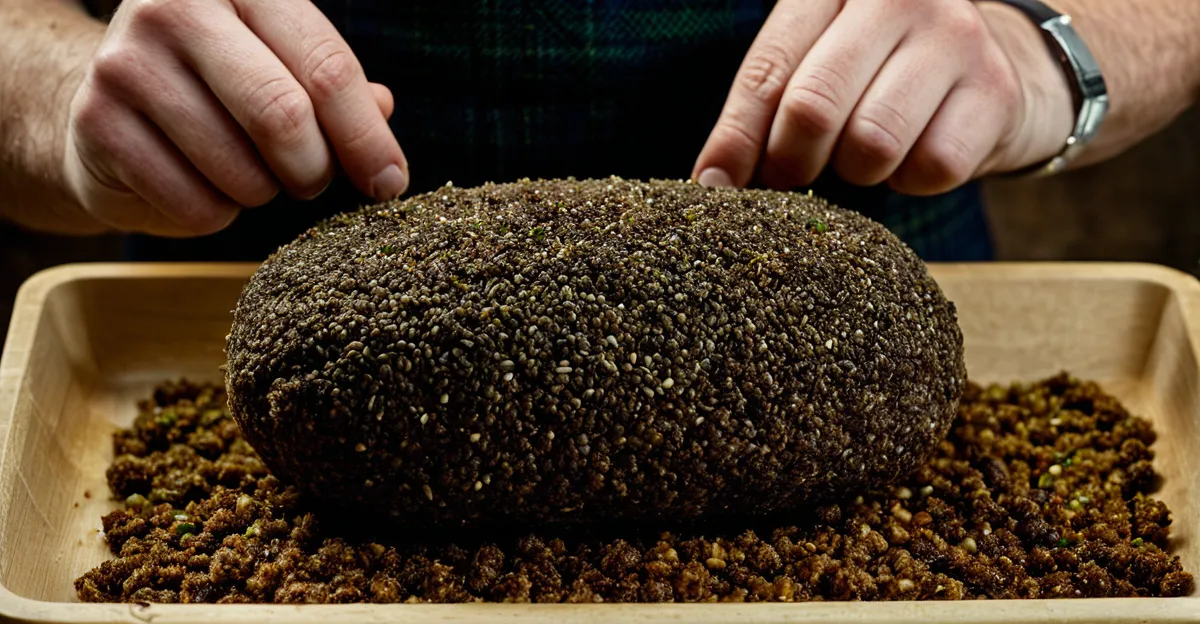Essential Ingredients and Sourcing for Authentic Scottish Haggis
To make authentic Scottish haggis, the cornerstone lies in selecting traditional organ meats, including lamb heart, liver, and lungs. These lamb organs impart haggis its distinctive rich and earthy flavor. When sourcing lamb organs, fresh and high-quality meat from trusted butchers or specialized suppliers is crucial, as the texture and taste depend heavily on ingredient quality.
For cooks unable to access lamb lungs—restricted in some regions—suitable substitutes such as beef or pork lungs can be considered. Alternatively, finely minced lamb kidney or extra liver may enhance flavor while maintaining authenticity. These substitutes for haggis keep the character intact without compromising safety.
Topic to read : What are the steps to creating a delightful Eton mess?
Beyond organs, the bulk of haggis consists of oats, traditionally toasted to a nutty aroma that balances the richness of the meat. Suet, the beef or mutton fat, adds moisture and depth. Carefully selecting mild spices such as ground black pepper, coriander, and a hint of nutmeg is essential for that signature warmth without overpowering.
Connecting each ingredient to its sourcing and quality highlights haggis as a product born of both tradition and thoughtful culinary technique, ensuring a genuine taste experience.
Also to discover : How can you recreate a traditional English trifle with modern twists?
Traditional and Modern Casings Explained
When making authentic Scottish haggis, sheep stomach is the traditional casing. It serves not only as a natural vessel but also imparts subtle flavour and maintains the classic texture. Sourcing sheep stomach for haggis usually involves specialized butchers or local markets familiar with traditional Scottish meat products. The stomach requires thorough cleaning and careful preparation to ensure safety and integrity during cooking.
However, some home cooks may find sourcing sheep stomach challenging or prefer an easier option. In these cases, practical haggis casing alternatives such as artificial casings or sturdy cooking bags designed for stuffing offer safe, accessible solutions. These alternatives mimic the containment function and allow even cooking, though they lack the distinct aroma and tradition tied to sheep stomach.
Choosing the right casing balances authenticity with modern convenience. For those pursuing traditional methods, obtaining quality sheep stomach remains key, whereas substitutes provide flexibility without compromising the essential qualities of haggis. Using appropriate casing helps preserve moisture and flavor, ensuring a successful outcome for both classic and adapted haggis recipes.
Step-by-Step Preparation Process
Preparing authentic Scottish haggis starts with meticulously cleaning and prepping the lamb organs—heart, liver, and lungs. Remove any membranes, blood vessels, and impurities. This step is crucial for ensuring a clean base. For those using substitutes for haggis like beef or pork lungs, the process remains similar, with thorough washing to maintain freshness and safety.
Next, soak and rinse the oats to soften them before lightly toasting to unlock their nutty flavor. Suet, the fat, should be finely chopped or grated to incorporate moisture evenly. Combining these with the prepared organ meats forms the core of the haggis mixture.
Spices like black pepper, coriander, and nutmeg are then blended in, giving the mixture its delicate warmth. Mix thoroughly but gently; overworking can alter texture.
Finally, stuff the mixture carefully into the chosen casing, whether traditional sheep stomach or practical haggis casing alternatives. Ensure the casing is tightly secured to prevent any leakage during cooking. This methodical approach to preparing the haggis mixture guarantees flavor balance and structural integrity for the iconic dish.
Cooking Techniques for Consistent Results
Mastering cooking haggis begins with traditional boiling. Place the prepared haggis in simmering water, ensuring it’s fully submerged. Maintain a gentle boil and cook for about 1.5 to 2 hours. This steady temperature lets the casing swell without bursting, preserving texture and flavor. Overboiling risks a split casing and dry filling.
For home cooks asking, how long to boil haggis? The answer is typically 90 to 120 minutes. Using a timer avoids overcooking; frequent, gentle movement during cooking prevents uneven heat distribution.
Modern kitchens benefit from adapting the process. Oven cooking involves wrapping haggis in foil and baking at moderate heat (around 180°C/350°F) for 2 to 2.5 hours. Electric and slow cookers offer controlled environments, requiring less monitoring and preserving moisture. Set the slow cooker on low with water in the cooker base to simulate boiling conditions, cooking for 3-4 hours.
When boiling haggis, always handle gently. Pricking the casing beforehand is discouraged, as it causes juices to leak, diminishing flavor. Closely monitor timing and temperature—these steps ensure a succulent, even-cooked haggis ready to honor Scottish culinary tradition.
Food Safety and Hygienic Practices
Ensuring haggis food safety starts with sourcing fresh, high-quality organ meats from reputable suppliers. Lamb heart, liver, and lungs should be inspected for freshness—avoid any off smells or discoloration. Thoroughly clean all meat by removing membranes and blood vessels, as this minimizes bacteria risks and improves texture.
When preparing organ meats, always use separate utensils and cutting boards to prevent cross-contamination. Wash hands regularly during preparation to maintain hygiene. Cooking organ meats safely requires heating the haggis mixture to an internal temperature of at least 70°C (160°F) to eliminate harmful pathogens.
Prevent contamination during cooking by avoiding pricking the casing; this preserves juices and flavor while reducing bacterial entry points. After cooking, serve haggis promptly or cool leftovers quickly to prevent bacterial growth.
Proper storage in airtight containers and refrigeration within two hours of cooking helps maintain safety and quality. When reheating, bring haggis to at least 75°C (165°F) throughout.
Adhering to these food safety practices ensures a delicious and safe experience, preserving the traditional flavors of authentic Scottish haggis without compromise.





